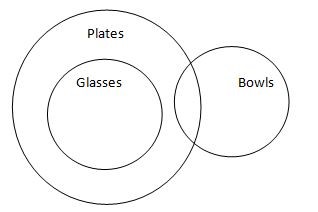Question
Statements: All glasses are plates. Some plates
are bowls. Conclusions:I. Some bowls are glasses. II. No bowl is a glass. In each of the questions below are given two statements followed by two conclusions numbered I and II. You have to take the given statements to be true even if they seem to be at variance with commonly known facts. Read all the conclusions and then decide which of given conclusions logically follows from the given statements disregarding commonly known facts. Give answerSolution
All glasses are plates(A) + Some plates are bowls (I) ⇒No conclusion. Hence conclusion I and II does not follow but they will form a complementary pair. Hence either I or II follows. Alternate Method: 
5,1,4,2,8 how many more pass are needed to finish sorting by bubble sorting technique?
What is the main objective of cluster analysis in data analytics?
What is the primary purpose of virtual memory in a computer system?
A physical DFD specifies
The ALU (Arithmetic Logic Unit) is responsible for:
What happens when a program accesses data that is not currently in physical memory (RAM) due to virtual memory management?
What is the main advantage of Network Attached Storage (NAS) technology?
Kirchhoff's Current Law (KCL) is based on the principle of:
In a pipelined CPU design, what is the purpose of the instruction pipeline?
Which number system is used to represent colors in HTML and CSS?
Relevant for Exams:


